The iPhone 6 Review
by Joshua Ho, Brandon Chester, Chris Heinonen & Ryan Smith on September 30, 2014 8:01 AM EST- Posted in
- Smartphones
- Apple
- Mobile
- iPhone 6
Camera
In order to really understand the camera of the iPhone 6, we have to first talk about the components that make up the camera system. While we don’t know the exact model number of either the iPhone 5s or iPhone 6 sensors, we do know that both the front and rear cameras are made by Sony. For the most part, it seems that the optical system is largely unchanged from the iPhone 5s to iPhone 6. The focal length and aperture are identical, and both have five plastic lenses. On the sensor side there are some obvious differences such as the addition of phase detection pixels. However, it’s otherwise difficult to say if anything else has changed in this area. There’s also a new ISP on the SoC, which serves to enable features like 240FPS slow motion video.
Based on what we know about the camera, the one highlight feature seems to be PDAF. While we’ve seen it before in phones like the Galaxy S5, we’ve never really talked about how it works. In short, microlenses on the sensor refract incoming light onto the AF detector in pairs, as seen in the photo below. Once this is done, the image produced by each AF sensor is compared for similarities. By finding these similarities, the ISP can know whether the lens is focused at a point short, long, or on the intended subject and command lens movement to focus on the intended subject. In case 1 in the photo, we see a situation where the camera is focused short, so the lens must move in order to properly focus on the subject, which is case 2. Case 3 and 4 show increasingly extreme cases of focusing too far to focus on the subject.
Source: Wikipedia
The real question is how it works. While we don't have an ideal test for auto focus and capture latency, we can at least get an idea for best case latency by looking at latency for both cases when viewing a well lit ISO chart, which has extremely high contrast and strong lighting so PDAF should be able to operate.

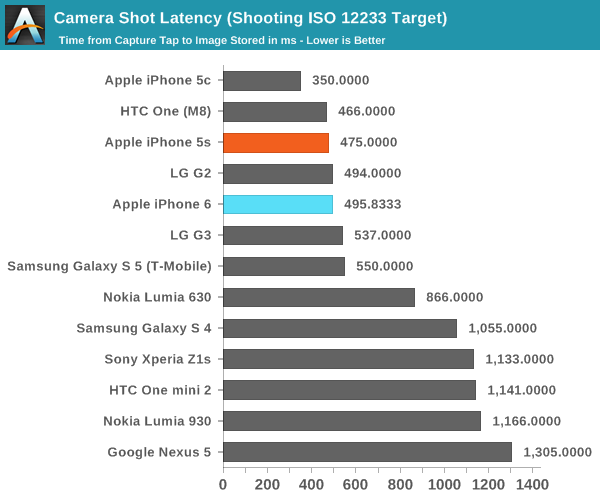
As you can see, it seems that capture latency is mostly unchanged when comparing the two phones but focus latency is dramatically improved in the best case, which is around 200 milliseconds. While the Galaxy S5 does have PDAF, in my experience it was hard to tell if it was any faster than a mostly contrast-based solution like the One M8. With the iPhone 6 the use of PDAF is immediately obvious because in well lit conditions the camera always snaps to focus without ever waiting for the ISP to detect an out of focus condition and run an AF scan. Oddly enough, in all of the manual camera applications that I've tried none of them seem to be able to use continuous auto focus in the preview, which suggests that this isn't exposed in the camera API.
On the UI side, the new camera application isn't a significant departure from what we're used to in iOS but there is one odd UI inconsistency present in the new UI, as in the slow motion video mode tapping the fps option will toggle between 120 and 240 fps but the same isn't true of 1080p60 video, which has to be toggled through the settings application instead of within the camera application.
Otherwise, I'm generally happy with the camera, especially with the new exposure biasing mode which does away with the need to try and get a specific exposure by locking exposure and reframing to get the right photo. While this certainly isn't a new feature the ease of use makes for a better implementation than most. Generally, exposure biasing is hidden in the settings menu so it's a setting that is only selected once and never again. However, Apple's solution will always default to 0 EV and allow for biasing by swiping up to increase exposure and down to reduce it, which means that this solution is fast and easy to do when taking a photo.
Overall, I don't have significant complaints with the camera UI or the general shooting experience. While I'm still looking for an ideal manual camera application I find Apple's mostly all auto solution to be more than sufficient. Of course, the shooting experience alone isn't enough to evaluate a camera so we'll look at image quality next.
Still Image Performance
While I'm still not quite happy with the state of our camera testing procedures, our current tests can generally give a good relative comparison, so the data we're looking at can still be used to draw some conclusions about the camera being tested. One of the first tests that we'll look at is the ISO chart, which uses increasingly tight line spacing to determine what the maximum resolution of the camera is.
In this test, the iPhone 6 does reasonably well, showing low aliasing until around the 16 or 17 mark, which seems to be about the same as the iPhone 5s. In general, this is one area where the iPhone falls short of the competition, which generally tends towards 1.1 micron pixels and sensor sizes larger than a third of an inch. However, it's definitely a great more detail than what we see on the four megapixel sensor of the One (M7) or One (M8). Given the sensor size constraints that Apple seems to be working with this is a respectable showing.
The next scene we'll look at is a daytime landscape shot. For the most part the iPhone 6 does admirably, as noise is well suppressed without noticeable oil painting effects that arise from when noise suppression is too strong and blurs out detail. Dynamic range is also generally quite good as shadowed areas have noticeable detail in this scene. In comparison to the iPhone 5s, while it's relatively hard to see any real differences in detail the noise in areas like the sky and in shadows are noticeably reduced without an obvious decrease in detail.
Following along the lines of the landscape shot, I also set up a lightbox scene with a few objects of varying contrasting textures, text, and feature size to get a good idea of what the limitations of the camera are. In this test scene, we actually see some level of improvement in detail when comparing the iPhone 5s to the iPhone 6. This is most obvious when looking closely at the texture of the metal bell. When compared to the Galaxy S5 LTE-A the iPhone 6 does fall behind a bit due to lower resolution and a mildly wider field of view.
For the next scene, I used the light box and standardized dim lighting in order to provide an example of camera performance between extremely bright and dark scenes. Here, it's relatively difficult to see a difference between the various phones, although with some cameras we're already starting to see a significant amount of detail blurred away in areas like the bell which has a great deal of low contrast detail. There's not too much difference here when comparing the iPhone 6 and 5s, although the 6 does have noticeably lower contrast in these situations.
At the extremes of low light photos, we definitely see a notable improvement in the iPhone 6, which can be attributed to the lower ISO. However, for better or worse we don't see a significant difference in exposure which suggests that this sensor likely has improved sensitivity despite identical pixel size. While we have no way of knowing the exact sensor, it's logical to conclude that the iPhone 6 is using a CMOS sensor process similar to the IMX240 in the GS5 LTE-A at a larger pixel pitch for better sensitivity. What's really incredible about this test photo is that the iPhone 6 manages to deliver an output close to what we see in the iPhone 6 Plus at four times the ISO/sensor gain.
The next two test cases are less about the camera itself and more about how well the OEM has integrated software and hardware. The first test we'll go over is the LED flash test in the lightbox scene that was previously used. While LED flash is generally a rather poor solution for low light photos, it's still important to test as there are some situations where it's absolutely necessary. In this case, Apple has done a great job of selecting an appropriate brightness level to evenly illuminate the scene and provided enough light to keep noise to a minimum, but for some reason there's a pink/red tint to the entire scene. This is one area where the iPhone 5s seems to provide more even color rendering as there is no such tint.
In the HDR test, there's a noticeable improvement in detail and dynamic range from the iPhone 5s to the iPhone 6. Key areas of note include the Media Link HD box, which has noticeably clearer text and there's also significantly more detail on the bell. Judging by the general improvements to detail in closer shots, it may be that these effects are either too subtle to see in landscapes or simply smudged away by noise reduction. There's relatively little to criticize here, as Apple seems to be effectively merging multiple exposures without obvious halos or similar effects that make HDR almost impossible to use in most circumstances.
Overall, the iPhone 6's camera represents a solid improvement over the previous generation, with less noise, more detail in some circumstances, better HDR, and improved low light performance. While it isn't a huge leap ahead, it's definitely more than one might expect. The improvements are subtle though, as there are no fundamental changes to the optics or sensor.








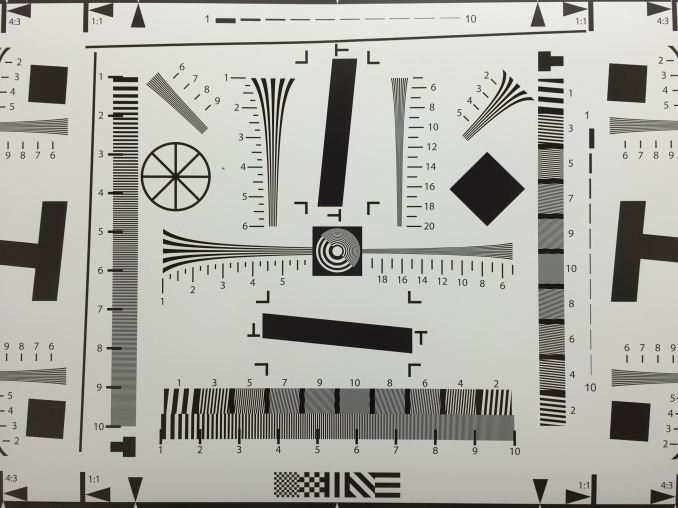






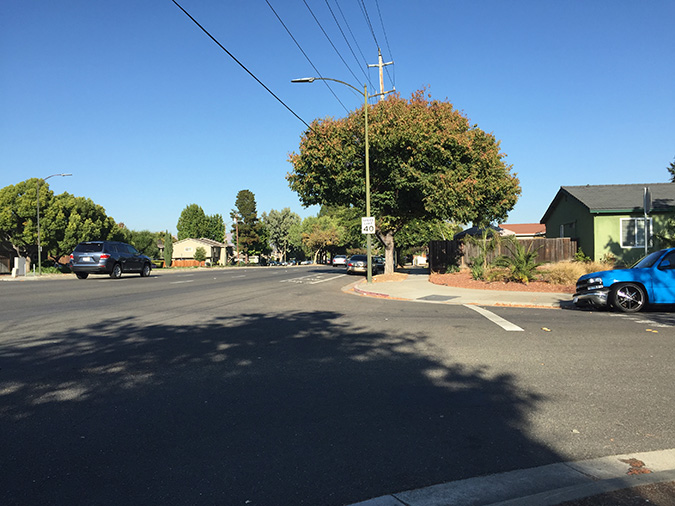






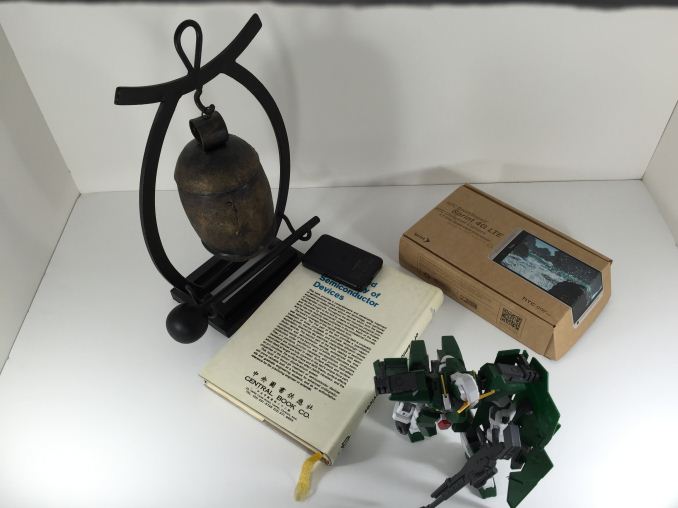






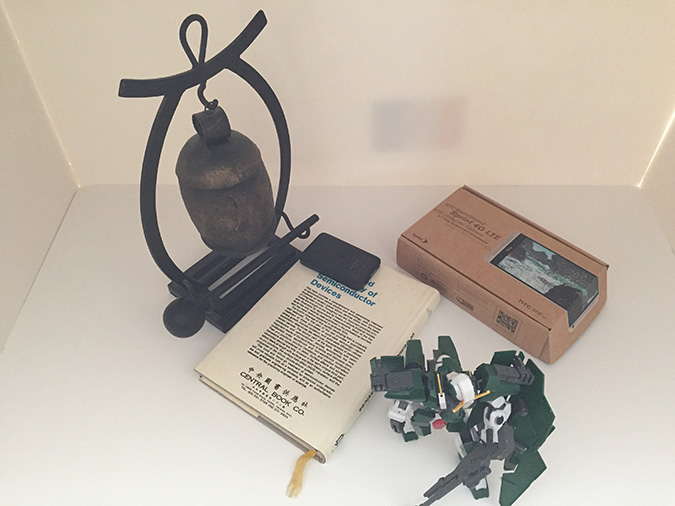






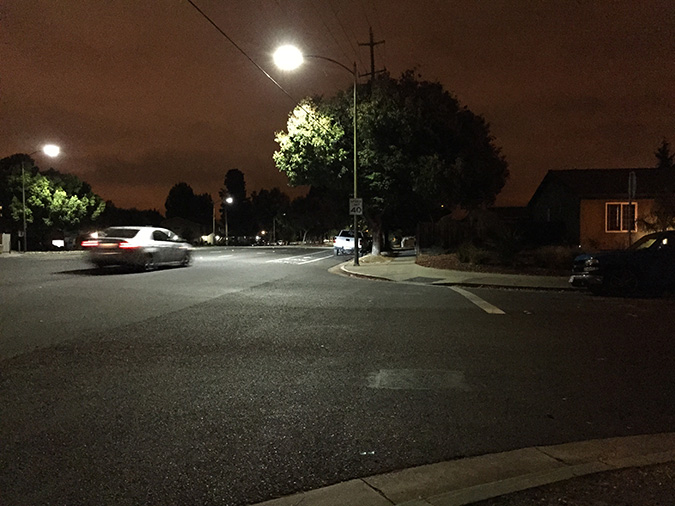









_thumb.jpg)



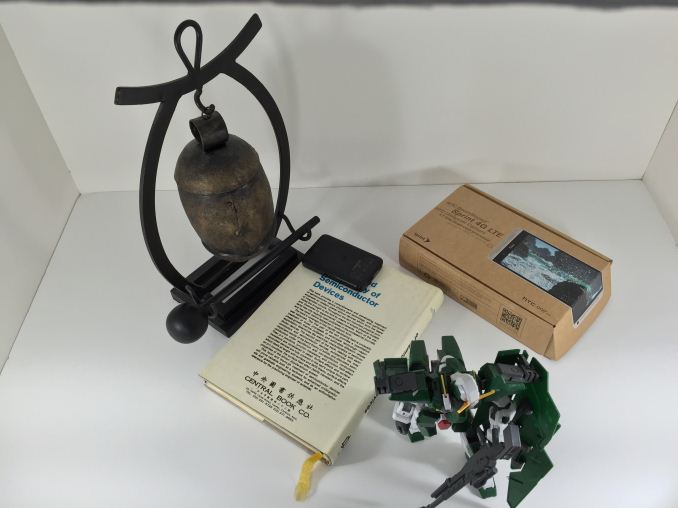








531 Comments
View All Comments
elajt_1 - Friday, October 3, 2014 - link
(@melgross) And to call you one would be an insult to an idiot.Apart from the rage, I think it was he made some valid points.
Jimrod - Tuesday, September 30, 2014 - link
You mad bro?rational_wannabe - Tuesday, September 30, 2014 - link
You have serious issues. So it's OK for Samsung to sell their plastic crap for the same amount of money? Nice way of rationalizing things...danbob999 - Tuesday, September 30, 2014 - link
Yeah it's OK since there is nothing wrong with plastic. It absorbs shock, is light and do not block wireless signal. Perfect material for a phone. It is also durable enough. How many people replace their phone because the plastic is cracked? Not much. People replace their phone either because the screen is broken, it was damaged by liquid or simply because it is too slow/old.Apple has been selling phones which are cheaper to produce for years at the same price (or higher) than the competition. Smaller phones tend to be cheaper, because the display is cheaper, the battery is cheaper, and the rest cost the same. So even by using plastic, Samsung phones cost more to produce so I fail to see how they can be labeled as "cheap".
blackcrayon - Tuesday, September 30, 2014 - link
Apple is spending far more in developing the phone in other areas though. Writing the OS, designing custom SoCs, etc.danbob999 - Tuesday, September 30, 2014 - link
Designing custom SoCs is an investment. It isn't supposed to raise the cost of the phone.Samsung also design some of its own SoCs and even manufacture them.
The OS is debatable. But from a hardware perspective Samsung phones (at least the high end ones) are definitely not cheap, even if they use plastic.
Parhel - Tuesday, September 30, 2014 - link
R&D should affect the cost of the product? That's not how it works . . .Parhel - Tuesday, September 30, 2014 - link
Ugh.. meant to say R&D "shouldn't". To state it plainly, R&D may be an investment, but it's still an expense. The cost needs to be recouped, and they make money by selling phones, so . . . you do the math.danbob999 - Tuesday, September 30, 2014 - link
Of course they have to make money. But spending more in software development, R&D or marketing doesn't make their phone any less "cheap". I was replying to someone saying that Samsung phones were "cheap" because they were in plastic. The fact is that Samsung phones tend to be more expensive than iPhones to make, because the cost of the components is higher, despite any savings made by using a plastic shell.akdj - Friday, October 3, 2014 - link
Only BECAUSE it takes my Note3 twice the cores, at twice the clock speed with three times the amount RAM to FINALLY close the gap on performance. Almost. My 5s is still quicker playing Asphalt8, manipulating photos, even rendering VIDEO! Most likely the latter because of the extreme lack of interet in the development community (other than game ports) to 'build out' apps and software. And that sucks! I love my Note 3--- coming from the original its a massive upgrade. That said, Samsung is using stock, off the shelf SoCs ....indeed 'produced' by them as they've got the capabilities to cook bake and roll out silicon BUT they've chosen to increase horsepower, drop the gearing ratios and add a stage III nirrous kit 'built' and low level programmed with basic ARM instructions and a radical slather of Peanut Butter JavaScript to wade through just for TouchWiz. By the time you open an app, you're at 85-90% RAM usage. I've got a N3. I like it and I'm not getting rid of it. It serves it's purpose for our business perfectly. But AS a business owner and one that relies on creative talent to make it 'work' I find your comment very VERY ill informed and 'ignorant' ...no to be a dick. But yes, R&D is definitely a percentage figured into the equation with BOM. As well, the software development, A8 & the second generation 64bit processor with a faster GPU, more efficient memory managment with the SoC 4mb buffer and iOS 8 itself are expenses. Paid to a LOT of talent! For crying out loud, they developed a new CODE! And a spectacular one at that! Free lessons are everywhere and if you're experienced, have a macbook laying around, download the latest XCode and you'll have Swift down in a weekend. Not to mentioned the low level 'Metal' instruction set to eliminate the OpGL ES overhead ...allowing developers 'direct' (hence, 'Metal') access to the GPU ...if you're at all curious on how incredible this development most consumers will NEVER know about ...check out Unreal 4's site, the UR4 engine and what they've done with Metal. You can download their patio presentation frim WWDC in the app store. It's absolutley amazing. Samsung's phones are spendy because they're licensing Wacom, using active digitizers few are able use (until this evolution, three's a charm I guess), massive batteries, a horrid looking bezel that's rigid for sure, but then again, this is the first I've seen people, on purposes bending phones, and that's not a real life issue or even concern. I shared earlier, somehow my nine year old son has managed to keep his iPod touch fifth gen in perfect non bent and scratch free condition. Two years. Lotsa boogers and bumps but no dents, no dings, scratches or 'display marks' without screen protection. Guesses can be made in physical pieces. Even how long (labor pricing) to produce a single unit. But development of actual silicon, low level optimization to your non fragmented operating system, 64bit technology 24 months ahead of the industry and obvious benefits from the 20nm A8. iOS 8 (and its counterpart more than ever, OS X 10.10) and its ability to aggregate our information across devices, handoff calls, emails, texts or whatever the hell you're doing on your iPad ....get distracted, fall out and when you turn your iMac or MBP on, there's the email you were working on. Ready for you to finish. The web page you were reading or the movie your were watching ...vice versa too. Start on your computer a doc, and open your iPhone, there'll be a small 'doc' icon signifying you're working on something and you're able to finish it here! Forget the phone downstairs, your in bed reading before sleep, phone rings...no worries. Answer it on your iPad. AirDrop between laptop, tablet and phone, MacPro and ipad....iPhone to your iMac, slick n quick.Of course, then there's the whole 'build quality' argument. Where designers, reviewers, and the public ALL Seem to agree. The iPhone SNOKES Samsung's BQ. Period. They're like jewelry, true and real 'art'. Each phone has been an engineering marvel. Samsung? Are you kidding me? Other than their goofy, curvy, earthy S3 baby blue tangent, their 'rectangle' phone lacks ANY design fundamentals much less achievements.
When you sell as MANY pieces as Apple does, costs come down. For the 'pieces'. But the machining process (2 year cycle) is entirely changed. Fusion welding and sapphire 'plants', robotics and laser/chamfered edging with incredible attention to detail are just a couple of the hundreds of THOUSANDS of re-tooling the facilities for the latest 'build'. And after a couple of hours today with the 6 & 6+ as we anxiously await ours, with an open mind (& as an ambidextrous user of Android and iOS Windows and OS X) --- NOTHING on the Internet does justice to the phone itself. It's. Absolutely. AMAZING!